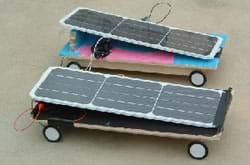Quick Look
Grade Level: 6 (6-8)
Time Required: 2 hours 30 minutes
(can be split into three 50-minute sessions)
Expendable Cost/Group: US $35.00
Group Size: 2
Activity Dependency: None
Subject Areas: Physical Science, Science and Technology

Summary
Students use engineering design principles to construct and test a fully solar powered model car. Several options exist, though we recommend the "Junior Solar Sprint" (JSS) Car Kits that can be purchased with direction from the federal government. Using the JSS kit from Solar World, students are provided with a photovoltaic panel that produces ~3V at ~3W. An optional accessory kit also from Solar World includes wheels, axles and drive gears. A chassis must be built additionally. Balsa wood provides an excellent option though many others are available. The testing of the solar car culminates in a solar race between classmates.Engineering Connection
Building and testing a solar car combines aspects of electrical and mechanical engineeering.
Learning Objectives
After this activity, students should be able to connect a solar photovoltaic panel to a motor and a run the motor forwards and backwards.
Educational Standards
Each TeachEngineering lesson or activity is correlated to one or more K-12 science,
technology, engineering or math (STEM) educational standards.
All 100,000+ K-12 STEM standards covered in TeachEngineering are collected, maintained and packaged by the Achievement Standards Network (ASN),
a project of D2L (www.achievementstandards.org).
In the ASN, standards are hierarchically structured: first by source; e.g., by state; within source by type; e.g., science or mathematics;
within type by subtype, then by grade, etc.
Each TeachEngineering lesson or activity is correlated to one or more K-12 science, technology, engineering or math (STEM) educational standards.
All 100,000+ K-12 STEM standards covered in TeachEngineering are collected, maintained and packaged by the Achievement Standards Network (ASN), a project of D2L (www.achievementstandards.org).
In the ASN, standards are hierarchically structured: first by source; e.g., by state; within source by type; e.g., science or mathematics; within type by subtype, then by grade, etc.
NGSS: Next Generation Science Standards - Science
-
Models can be used to represent systems and their interactions.
(Grades 6 - 8)
More Details
Do you agree with this alignment?
Common Core State Standards - Math
-
Display numerical data in plots on a number line, including dot plots, histograms, and box plots.
(Grade
6)
More Details
Do you agree with this alignment?
International Technology and Engineering Educators Association - Technology
-
Troubleshooting is a problem-solving method used to identify the cause of a malfunction in a technological system.
(Grades
6 -
8)
More Details
Do you agree with this alignment?
-
Use tools, materials, and machines to safely diagnose, adjust, and repair systems.
(Grades
6 -
8)
More Details
Do you agree with this alignment?
-
Apply the technology and engineering design process.
(Grades
6 -
8)
More Details
Do you agree with this alignment?
State Standards
North Carolina - Math
-
Display numerical data in plots on a number line, including dot plots, histograms, and box plots.
(Grade
6)
More Details
Do you agree with this alignment?
North Carolina - Science
-
Recognize that energy can be transferred from one system to another when two objects push or pull on each other over a distance (work) and electrical circuits require a complete loop through which an electrical current can pass.
(Grade
7)
More Details
Do you agree with this alignment?
-
Understand forms of energy, energy transfer and transformation and conservation in mechanical systems.
(Grade
7)
More Details
Do you agree with this alignment?
-
Analyze the nature of moving charges and electric circuits.
(Grades
9 -
12)
More Details
Do you agree with this alignment?
Materials List
JSS-KIT and JSS-ACC (solar car and accessory kit): The Junior Solar Sprint (JSS) kit and accessory kit may be bought separately from Solarmade with the following materials:
- solar panel
- 2 axles
- 4 wheels (sized to fit axle)
- driving gear (sized to fit axle)
- electric, DC powered motor
- different gears for motor
- drill with bits is also needed to help size gears to fit axles
Chassis materials:
- balsa wood – flat 4x 8 inch boards and ½ x ½ inch pieces
- wood glue
- paints for decoration
- paint brushes
- utility knives
Worksheets and Attachments
Visit [www.teachengineering.org/activities/view/duk_solarcar_tech_act] to print or download.Pre-Req Knowledge
Students should have completed the lesson "From Sunlight to Electric Current."
Introduction/Motivation
Cars are intrinsically exciting to many students. Solar-powered cars are even more so. Very little is required to motivate students to engage in this project. Discussing solar car competitions in which college students participate and providing some statistics about those solar cars and the challenges they face can be a good way to introduce this activity.
Procedure
Direct students to construct their cars in the following manner:
- Set up the car body (chassis).
- Add the axle and wheels.
- Add the motor.
- Then mount the solar panels.
- Once the vehicle is completed, begin testing (weather permitting).
- The activity culminates in a race!
Also consider the following:
- While using the materials listed above, give students the freedom to choose their own designs.
- Photovoltaic cells do not deliver nearly as much power to a motor as a battery does. Keep your solar cars light.
- Judge where your motor should go BEFORE you add it to the body.
- Make sure your panels point towards the sun and that they are steady.
Vocabulary/Definitions
axle: The supporting shaft on which a set of wheels revolves.
chassis: The frame that holds the body and motor of an automobile together.
conductor: A material that allows electricity to move through it easily. That is, it is a material with low electrical resistance, one in which a fairly small voltage will produce a fairly large current.
current: Movement of electrons.
photovoltaic cell: A semiconductor device that converts the energy of sunlight into electric energy.
voltage: Designates "electric pressure" that exists between two points and is capable of producing a flow of current when a closed circuit is connected between the two points (can also be considered with the analogy of elevation: just as a hill will have water flow down it, a voltage will have current flow in the direction from high to low).
Assessment
Questions: Ask students to answer the following questions in writing in order to gauge their comprehension:
- Did the angle of the solar panel affect the performance of your car? Why?
- How does the sun power your car? Please explain each step.
- As a class, create a histogram of the solar car results. Discuss the distribution, and what factors affect how fast each solar car travels.
Investigating Questions
- How can the power created by the solar cells be maximized? (A possible answer: The sun light should be striking the surface of the solar panel at about 90 degrees.)
- How can acceleration be maximized? (Work with gear ratio.)
Safety Issues
- A drill may be needed to bore out the holes for the gears and wheels. Only instructors should do this. A nail just smaller than the axle may also be used to bore out the holes if necessary.
- Glue should not be ingested.
- Use of utility knives should be supervised.
Troubleshooting Tips
If the motor is running backwards, reverse the wires.
If acceleration seems to be quite slow or the motor is not producing enough torque to get the car moving from rest, change the gear ratio.
Activity Extensions
If the teacher is interested, students may use these kits to compete in the Junior Solar Sprint competition sponsored by the National Renewable Energy Laboratories.
Subscribe
Get the inside scoop on all things TeachEngineering such as new site features, curriculum updates, video releases, and more by signing up for our newsletter!Copyright
© 2014 by Regents of the University of Colorado; original © 2004 Duke UniversityContributors
Rahmin Sarabi; Roni PruczSupporting Program
Techtronics Program, Pratt School of Engineering, Duke UniversityAcknowledgements
This content was developed by the MUSIC (Math Understanding through Science Integrated with Curriculum) Program in the Pratt School of Engineering at Duke University under National Science Foundation GK-12 grant no. DGE 0338262. However, these contents do not necessarily represent the policies of the NSF, and you should not assume endorsement by the federal government.
Last modified: April 14, 2020






User Comments & Tips